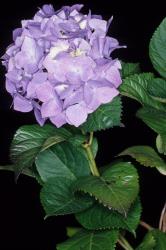- Taxon
- Weed
- Gallery
- ≡ Viburnum macrophyllum Thunb. in Murray, Syst. Veg., ed. 14 (J. A. Murray) 295 (1784)
Deciduous, densely-branched, rounded shrub to 1.5–(3) m high; twigs glabrous and flexible, becoming mottled and brittle. Lvs towards ends of branches on younger wood; petiole short; lamina elliptic to ovate or obovate, (5)–10–20 × (3)–5–15 cm, acuminate, cuneate, coarsely serrate; both surfaces glabrous and greasy, the upper lustrous, the lower dull with a conspicuous network of veins. Corymb broad, flat-topped or convex, much-branched, hairy, up to 20 cm diam., usually largely composed of sterile fls, sometimes with an outer ring of sterile fls and central fls fertile. Sepals of sterile fls petaloid, spreading, broad-elliptic to obovate, 1–2 cm long, pink, blue, white, or greenish. Corolla c. 3 mm diam.; petals minute and incurved, pink or blue. Stamens 10. Ovary enclosed in calyx tube at anthesis, later projecting. Capsule c. 5 mm long.
[From: Webb et al. (1988) Flora of New Zealand. Volume 4.]
Flowering: Nov.–Mar.




